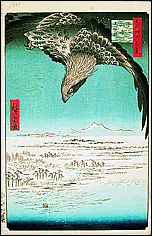|
|
|
 |
| 1 |
2 | 3 | 4 | 5 | |
|
COLUMBIA
FORUM
One Hundred Famous Views of
Edo
A member of
the samurai class and a hereditary retainer of the Tokugawa
shogunate, Utagawa Hiroshige (1797-1858) began studying
ukiyo-e art (depictions of daily life) while a teenager. In
addition to his main occupation as a fireman protecting the nearby
Edo Castle, he became one of the most celebrated artists of
nineteenth-century Japan, known for his expressive use of color,
skillful compositions and influence on artists in Japan and the
West.
"Hiroshige:
One Hundred Famous Views of Edo," which was on display at the
Brooklyn Museum of Art from February 18 to April 23, 2000, showed
the full scope of Hiroshige's craft. Executed between 1856 and
1858, this series (which actually numbers 118) - here illustrated
by Fukagawa Susaki Jumantsubo and Yoroi Ferry - is
recognized as a prime example of ukiyo-e art and one of the
most famous depictions of Edo (modern Tokyo). "It is the first time
that the Brooklyn Museum has ever shown the complete set at once,"
says Professor of East Asian Languages and Cultures Henry D.
Smith II. "In the end, Hiroshige went beyond the promised 100
of the title and might have gone further still had the series not
been terminated by his death in the cholera epidemic of
1858."
Even though
Smith is teaching history at the Kyoto Center for Japanese Studies
in Japan this year, he has a special interest in the exhibit. In
1986, when the Brooklyn Museum decided to display a selection of
the prints in four separate shows, Smith, then a professor at the
University of California, was asked to co-write the text for the
accompanying catalogue. It was subsequently translated into several
languages, including Japanese, and has become the standard
reference on Hiroshige and these prints. In the Brooklyn exhibit,
Smith's catalogue text has been used in the descriptions that
accompanied the prints. (Art publisher George Braziller has
reissued the catalogue for the new exhibit.) Smith also contributed
an article on Hiroshige for a special issue the art journal
Orientations, published in conjunction with several New York
museums.
"The BMA set
of Hiroshige's '100 Views' remains one of the most satisfying
research projects of my career as a historian of Japan," says
Smith.
 |
| 1 |
2 | 3 | 4 | 5 | |
|
|
|
|




